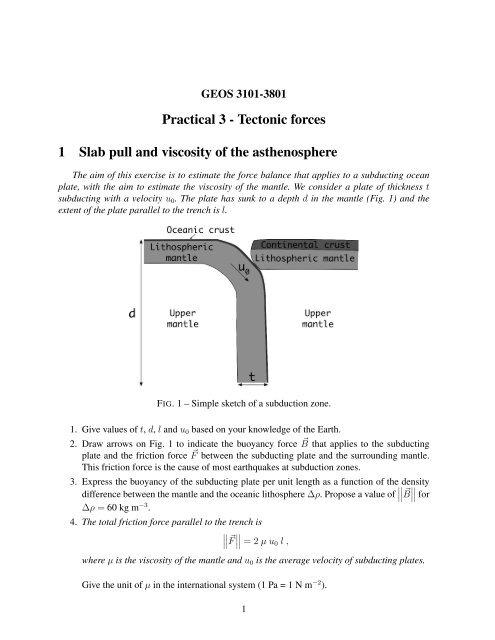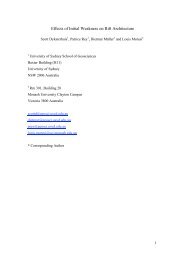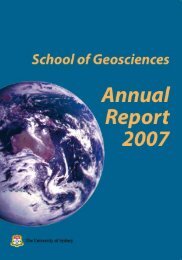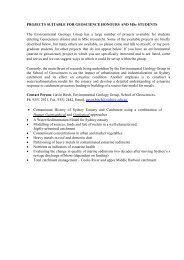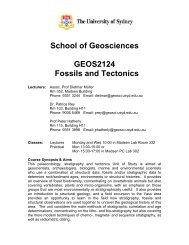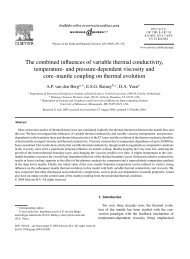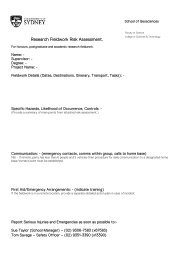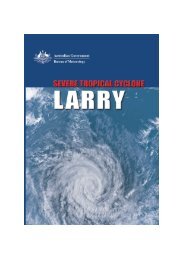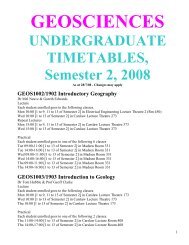Practical 3 - Tectonic forces 1 Slab pull and viscosity of the ...
Practical 3 - Tectonic forces 1 Slab pull and viscosity of the ...
Practical 3 - Tectonic forces 1 Slab pull and viscosity of the ...
You also want an ePaper? Increase the reach of your titles
YUMPU automatically turns print PDFs into web optimized ePapers that Google loves.
GEOS 3101-3801<br />
<strong>Practical</strong> 3 - <strong>Tectonic</strong> <strong>forces</strong><br />
1 <strong>Slab</strong> <strong>pull</strong> <strong>and</strong> <strong>viscosity</strong> <strong>of</strong> <strong>the</strong> as<strong>the</strong>nosphere<br />
The aim <strong>of</strong> this exercise is to estimate <strong>the</strong> force balance that applies to a subducting ocean<br />
plate, with <strong>the</strong> aim to estimate <strong>the</strong> <strong>viscosity</strong> <strong>of</strong> <strong>the</strong> mantle. We consider a plate <strong>of</strong> thickness t<br />
subducting with a velocity u 0 . The plate has sunk to a depth d in <strong>the</strong> mantle (Fig. 1) <strong>and</strong> <strong>the</strong><br />
extent <strong>of</strong> <strong>the</strong> plate parallel to <strong>the</strong> trench is l.<br />
FIG. 1 – Simple sketch <strong>of</strong> a subduction zone.<br />
1. Give values <strong>of</strong> t, d, l <strong>and</strong> u 0 based on your knowledge <strong>of</strong> <strong>the</strong> Earth.<br />
2. Draw arrows on Fig. 1 to indicate <strong>the</strong> buoyancy force ⃗ B that applies to <strong>the</strong> subducting<br />
plate <strong>and</strong> <strong>the</strong> friction force ⃗ F between <strong>the</strong> subducting plate <strong>and</strong> <strong>the</strong> surrounding mantle.<br />
This friction force is <strong>the</strong> cause <strong>of</strong> most earthquakes at subduction zones.<br />
3. Express <strong>the</strong> buoyancy <strong>of</strong> <strong>the</strong> subducting plate per unit length as a function <strong>of</strong> <strong>the</strong> density<br />
difference between <strong>the</strong> mantle <strong>and</strong> <strong>the</strong> oceanic lithosphere ∆ρ. Propose a value <strong>of</strong> ∣∣B<br />
⃗ ∣∣ for<br />
∆ρ = 60 kg m −3 .<br />
4. The total friction force parallel to <strong>the</strong> trench is<br />
∣∣F<br />
⃗ ∣∣ = 2 µ u 0 l ,<br />
where µ is <strong>the</strong> <strong>viscosity</strong> <strong>of</strong> <strong>the</strong> mantle <strong>and</strong> u 0 is <strong>the</strong> average velocity <strong>of</strong> subducting plates.<br />
Give <strong>the</strong> unit <strong>of</strong> µ in <strong>the</strong> international system (1 Pa = 1 N m −2 ).<br />
1
5. Give an expression for µ assuming equilibrium between <strong>the</strong> <strong>forces</strong> at <strong>the</strong> subducting plate<br />
per unit length.<br />
Does this hypo<strong>the</strong>sis correspond to weak or to strong coupling between <strong>the</strong> mantle <strong>and</strong><br />
<strong>the</strong> subducting plate ?<br />
Propose a value <strong>of</strong> µ. Is this value a lower or a greater bound for µ ?<br />
2 Ridge push calculated in <strong>the</strong> half-space cooling model<br />
The aim <strong>of</strong> this problem is to combine notions <strong>of</strong> heat diffusion <strong>and</strong> isostasy in order to estimate<br />
<strong>the</strong> ridge-push as a function <strong>of</strong> <strong>the</strong> age <strong>of</strong> <strong>the</strong> ocean floor.<br />
FIG. 2 – Bathymetry <strong>of</strong> <strong>the</strong> ocean floor due to <strong>the</strong> cooling <strong>of</strong> <strong>the</strong> lithosphere.<br />
1. Derive <strong>the</strong> literal expression, written using integrals, <strong>of</strong> <strong>the</strong> isostatic equilibrium between<br />
<strong>the</strong> mid-oceanic ridge <strong>and</strong> <strong>the</strong> oceanic plate at a distance l from <strong>the</strong> ridge at <strong>the</strong> compensation<br />
depth d.<br />
2
2. Integrate <strong>the</strong> expression written in 1. to express <strong>the</strong> isostatic balance between <strong>the</strong> ridge <strong>and</strong><br />
<strong>the</strong> abyssal plain using densities, <strong>the</strong> lithospheric thickness Z L <strong>and</strong> <strong>the</strong> water depth w.<br />
3. The change in density <strong>of</strong> <strong>the</strong> oceanic lithosphere with temperature is given by<br />
∆ρ = −ρ α ∆T, (1)<br />
where α is <strong>the</strong> coefficient <strong>of</strong> <strong>the</strong>rmal expansion <strong>and</strong> ρ is <strong>the</strong> reference density.<br />
Considering cooling in one direction extending to infinity (“half-space cooling model"),<br />
<strong>the</strong> temperature pr<strong>of</strong>ile <strong>of</strong> <strong>the</strong> oceanic lithosphere can be written as<br />
⎛<br />
T m − T L<br />
= erfc ⎝<br />
T m − T 0<br />
√<br />
2<br />
⎞<br />
z<br />
⎠ , (2)<br />
κx/u 0<br />
where erfc is <strong>the</strong> complementary error function, κ is <strong>the</strong> <strong>the</strong>rmal diffusivity <strong>of</strong> <strong>the</strong> lithosphere<br />
<strong>and</strong> u 0 is <strong>the</strong> spreading rate <strong>of</strong> <strong>the</strong> oceanic plate.<br />
Combine equations 1 <strong>and</strong> 2 to express <strong>the</strong> density difference between <strong>of</strong> <strong>the</strong> oceanic lithosphere<br />
<strong>and</strong> <strong>the</strong> mantle using <strong>the</strong> temperature pr<strong>of</strong>ile <strong>of</strong> <strong>the</strong> oceanic lithosphere predicted by<br />
<strong>the</strong> half-space cooling model.<br />
4. One <strong>of</strong> <strong>the</strong> properties <strong>of</strong> <strong>the</strong> error function is that<br />
∫ ∞<br />
0<br />
⎛<br />
erfc ⎝<br />
√<br />
2<br />
⎞<br />
z<br />
κx/u 0<br />
√<br />
⎠ κx<br />
dz = 2 .<br />
πu 0<br />
In <strong>the</strong> half-space cooling model, because ρ → ρ m <strong>and</strong> T → T m at <strong>the</strong> base <strong>of</strong> <strong>the</strong> lithosphere,<br />
<strong>the</strong> upper limit <strong>of</strong> <strong>the</strong> integral can be changed from ∞ to Z L .<br />
Using <strong>the</strong> literal expression that you wrote in 1., express <strong>the</strong> water depth w as a function<br />
<strong>of</strong> <strong>the</strong> age <strong>of</strong> <strong>the</strong> ocean floor.<br />
5. Using <strong>the</strong> concept <strong>of</strong> gravitational potential energy, express <strong>the</strong> norm <strong>of</strong> <strong>the</strong> force ∣∣F<br />
⃗ ∣∣<br />
resulting from <strong>forces</strong> ⃗ F 1 <strong>and</strong> ⃗ F 2 between <strong>the</strong> mid-oceanic ridge <strong>and</strong> <strong>the</strong> oceanic plate at a<br />
distance l from <strong>the</strong> ridge.<br />
Note : w is not <strong>the</strong> compensation depth - <strong>the</strong> calculation is carried out at that depth to<br />
simplify <strong>the</strong> problem.<br />
3
6. Advanced students :<br />
The full expression <strong>of</strong> <strong>the</strong> ridge-push is given by<br />
where t is <strong>the</strong> age <strong>of</strong> <strong>the</strong> ocean floor.<br />
∣∣F ⃗ ∣∣ ∣∣ ∣∣ ∣∣ ∣∣ R = ∣∣ ∣∣ F ⃗ ∣∣ ∣∣ + gρm α(T m − T 0 )κt, (3)<br />
Calculate <strong>the</strong> ridge-push for ocean floor 80 million years old using <strong>the</strong> values given in<br />
Table 1.<br />
Compare this result to <strong>the</strong> one you obtained for question 3 <strong>of</strong> <strong>the</strong> previous exercise, <strong>and</strong><br />
comment.<br />
TAB. 1 – Values <strong>of</strong> <strong>the</strong> parameters used in <strong>the</strong> problem.<br />
Parameter Meaning Value Unit (model)<br />
T m temperature <strong>of</strong> <strong>the</strong> upper mantle 1330 ◦ C<br />
T 0 temperature <strong>of</strong> <strong>the</strong> deep ocean 0 ◦ C<br />
g acceleration <strong>of</strong> <strong>the</strong> gravity field 9.81 m s −2<br />
α coefficient <strong>of</strong> <strong>the</strong>rmal expansion 3 × 10 −5 K −1<br />
κ <strong>the</strong>rmal diffusivity 1 × 10 −6 m 2 s −1<br />
ρ m density <strong>of</strong> <strong>the</strong> mantle 3340 kg m −3<br />
ρ w density <strong>of</strong> <strong>the</strong> ocean water 1030 kg m −3<br />
4


